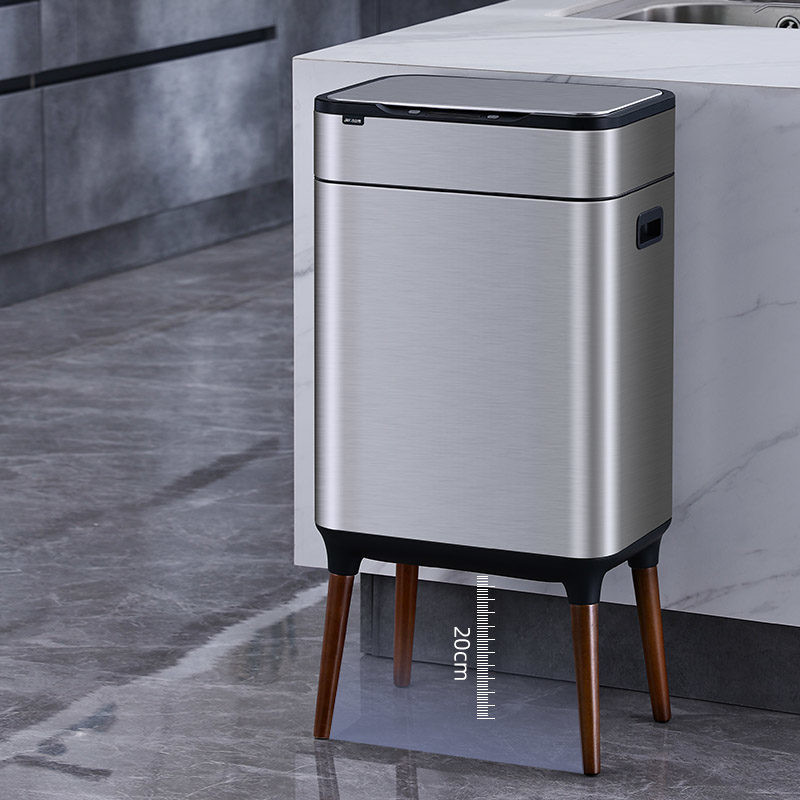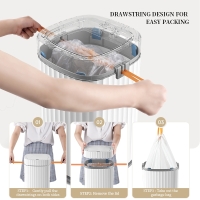What Is Tthe Kitchen Smart Trash Can
05-13-2025
Kitchen Smart Trash Can is a household device that integrates advanced technology and is designed specifically for kitchen scenarios, aiming to enhance the convenience, hygiene, and environmental friendliness of waste disposal. The following is a detailed analysis of its core features and functions:

1、 Core functions and technologies
Intelligent sensing lid opening
Most products use infrared sensing technology, which automatically opens the lid when the user's hand or object approaches, avoiding direct contact and reducing the risk of bacterial transmission. For example, the kitchen specific version of the wheat barrel uses wave sensing to quickly open the lid, with silent operation and high sensitivity. Some high-end models also support diversified triggering methods such as "kick kick music", making it convenient to use when holding objects with both hands.
Odor prevention and sealing design
In response to the problem of kitchen waste easily producing odors, Smart Trash Cans usually adopt a double-layer sealed structure and activated carbon filtration technology to effectively block the spread of odors. For example, EKO brand trash cans eliminate 99% of odors and prevent mosquito breeding through negative oxygen ion generators.
Large capacity and automatic compression
The capacity of kitchen specific models is usually between 12-30L, and some products are equipped with automatic compression function, which can reduce the volume of garbage by 50% and significantly increase the actual loading capacity. For example, JD Jingzao's 30L garbage can uses compression technology to make a 12L capacity garbage can accommodate the equivalent of 18L of garbage.
Garbage classification and intelligent recognition
By 2025, high-end models will have popularized AI image recognition and voice interaction technology. For example, the intelligent AI garbage bin in Binhai High tech Zone can automatically classify through voice commands, with an accuracy rate of up to 98%, and supports a point incentive mechanism, allowing users to correctly place redeemable gifts. Some products can also monitor the type and weight of garbage in real time through mobile apps, and generate home health reports.
2、 Scenario based design
Leak proof and easy to clean
In response to the problem of liquid leakage from kitchen waste, brands such as wheat barrels adopt a double-layer inner liner design. Even if the garbage bag is damaged, the liquid will not seep into the outer body of the barrel. Simply remove the inner liner and rinse it. In addition, the stainless steel cover plate and footrest area are easier to clean, avoiding oil residue.
Silent and user-friendly operation
The damping design when closing the door can avoid noise and is suitable for home environments. For example, the foot operated garbage bin of a wheat bucket slowly closes its cover after releasing the foot pedal to reduce interference. Some models are also equipped with LED lighting for easy use at night.
Adapt to kitchen workflow
Narrow design (such as 10L model) can be embedded in cabinet gaps to save space. For example, the narrow slit garbage bin made by JD Jingzao is designed specifically for bathrooms and kitchens, with a large opening size that can directly store large items such as beverage bottles.
3、 Market Trends and Technological Innovation
Environmentally friendly materials and sustainability
By 2025, biodegradable materials such as bamboo fiber will appear in the market, increasing the antibacterial rate by 30%, while supporting recyclable garbage bags to help achieve carbon neutrality goals. Some brands also use solar power to achieve "zero carbon operation and maintenance".
The linkage between the Internet of Things and smart homes
High end products support connection with mobile apps, providing overflow reminders, remote control, and other functions. For example, Midea's Smart Trash Can can can be linked to a smart refrigerator to automatically restock when expired food is detected. In addition, some cities are piloting a "points system" where users can redeem shopping vouchers by correctly categorizing them, promoting environmental behavior.
Health and Safety Upgrades
The ultraviolet sterilization function has become a standard feature of high-end models, which can reduce 99% of bacteria such as Escherichia coli when turned on. Structural safety testing (such as compression and drop resistance) and electrical safety certification (such as IPX4 waterproofing) ensure the long-term reliability of the product.
4、 Mainstream brands and price ranges
High cost-effective option (100-300 yuan)
JD Jingzao, Supor and other brands offer basic models with induction opening, sealing and odor prevention functions, priced between 89-259 yuan. For example, JAH's 15L stainless steel trash can set (including garbage bags) is suitable for families with limited budgets.
Mid to high end models (300-800 yuan)
The JAH brand focuses on automatic packaging and bag changing function, which can save 15 yuan in garbage bag costs per month. For example, JAH sensor trash can, Support one click automatic packaging to avoid contact with garbage.
Flagship model (over 800 yuan)
The high-end models of JAH brand are equipped with AI classification, UV sterilization and other functions. For example, JAH's thousand yuan model reduces bacteria by 99% through UV sterilization and supports overflow alarm.
5、 User reviews and purchasing suggestions
Core advantages
Hygiene and convenience: contactless operation reduces bacterial transmission, especially suitable for handling kitchen waste.
Environmental Assistance: Automatic classification and point incentives improve the accuracy of garbage classification, with pilot community data showing a classification accuracy rate of 92%.
Durability: The stainless steel material and low-power design ensure long-term use, and some models can last up to six months.
precautions
Maintenance cost: Electronic components require regular battery replacement or charging, and some brands offer on-site repair services.
Space adaptation: Choose the capacity according to the kitchen area, 13L is suitable for small families, and 20L or more is suitable for multi population families.
Compatibility: Prioritize models that support ecosystems such as Mi Home and Huawei HiLink to achieve smart home connectivity.
6、 Future development direction
The technology of Smart Trash Cans will be further deepened in 2025, for example:
Deep application of AI: optimizing classification accuracy through machine learning, and even analyzing household waste data to provide health recommendations.
Material innovation: Biodegradable materials and nano coating technology will reduce environmental impact.
Urban management integration: IoT technology enables the linkage between garbage bins and environmental sanitation systems, achieving real-time monitoring and automatic scheduling of garbage volume.
In summary, the Kitchen Smart Trash Can is not only a "lazy tool" for home cleaning, but also a microcosm of the integration of environmental protection and technology, redefining the standards of kitchen waste disposal through intelligent design.
















